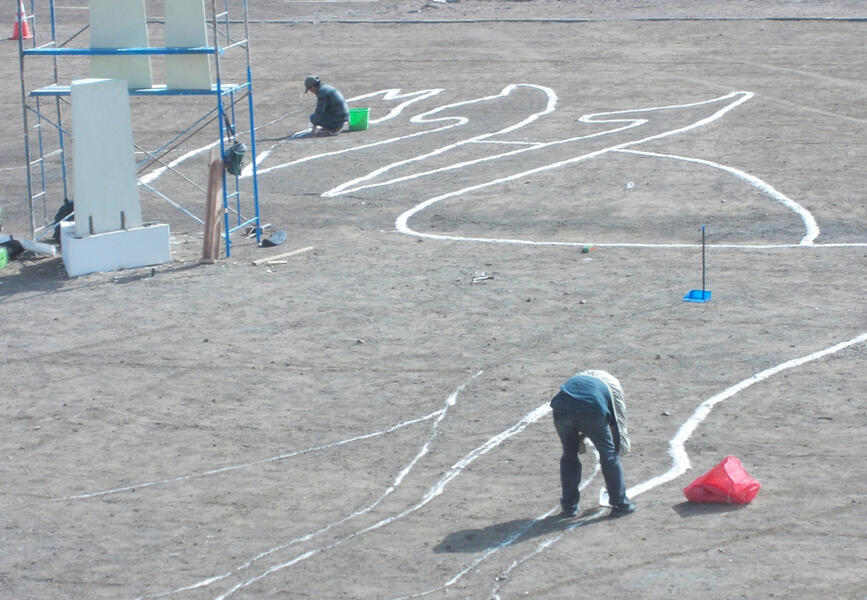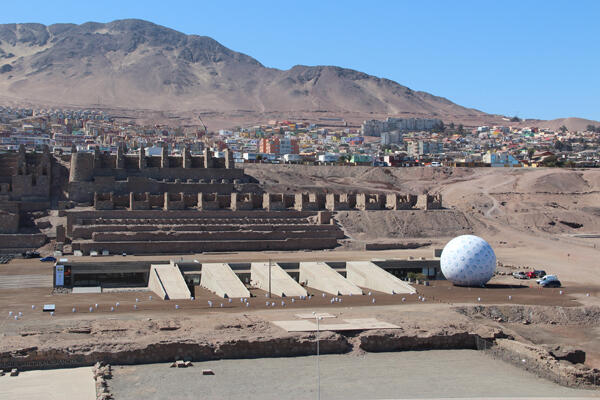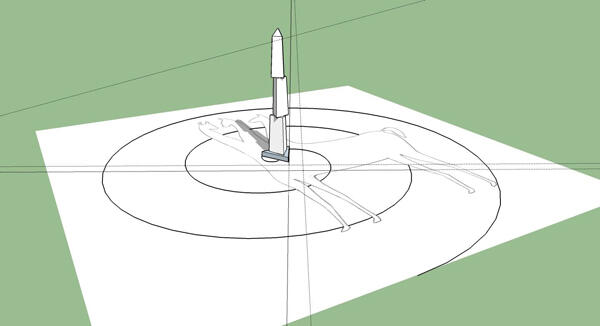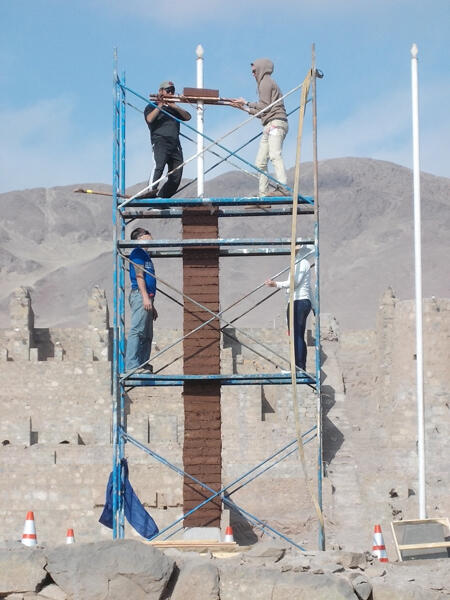ARTISTS FROM PERU, BOLIVIA AND CHILE PONDER ON THE SUBJECT _MY NEIGHBOUR. THE OTHER_ IN THE 3RD WEEK OF CONTEMPORARY ART IN ANTOFAGASTA.
August 21st to 31th in Parque Cultural Huanchaca
In a context where the desert is a geographic reality as much as a metaphor in terms of the scene, the Week of contemporary Art or SACO is instated as a unique event in a national level, as a decentralizing statement that also projects the north of Chile internationally.

The initiative came up two years ago en Antofagasta from the SE VENDE collective mobile platform of Contemporary Art, with the objective of closing the gap between the local audience and the current local production, and also build a platform of bounding and dialogue, open to diversity, dynamic.
On the edge of the Atacama desert, something was growing: the economic growth of a city due to big scale mining, the emergency of a new and restless generation, fed by the flux of information in global networks, and as well some efforts of selfmanagement and production. In fact, SE VENDE, is an emblematic group, being for ten years the idea of the cultural producer Christian Núñez and the Polish artist living in Chile, Dagmara Wyskiel.
The first version of SACO, in 2012, included an exposition of international art that occupied an emblematic space of the city, the Estación Antofagasta cultural center. Under the curatory of Argentinian Marisa Caichiolo, artist from Mexico, Chile, Argentina and Egypt, they presented all class of works and realized art workshops open to the public. A year later and from Parque Cultural Huanchaca, SACO2 proposed as a subject a particular phenomena of the country, as is the emergency of autonomous management in provinces or in peripheral areas to the epicenters of art. Due to this, key directors of important projects: Móvil, of Concepción; Galería Metropolitana, from Pedro Aguirre Cerda; and Curatoría Forense, which is spread between Cordova (Argentina) and Villa Alegre (Chile), to participate of a week of working between themselves and the audience. Local artists joined with an exposition inside the museum and intervention on the surrounding area.
In this encounters and in other visits, in parallel has been activated as a place for residences, actions and art interventions, Quillagua, Aymaran settlement that -after of having grown in an oasis of the Loa river- now suffers the abuse on water usage, being declared the driest place on Earth.
From the 21st to the 31th of August 2014, SACO3 emphasizes its international character, aiming to the problematic relationship between Peru, Bolivia and Chile, key subject of the territory and identity, that pierces the political, social and cultural spheres. Under the title “My Neighbor. The Other”, this version starts from the statement that “through art it is possible to deepen into broken terrain, that few dare to touch”, says Dagmara Wyskiel, the director.
Embracing the call of SE VENDE collective, curators, investigators and visual artists from the three countries join into conferences, workshops and publications, giving shape as well to the exposition “My Neighbor. The Other”, open in Parque Cultural Huanchaca.
Among the curators are the renown: Gustavo Buntinx (Perú), Lucía Querejazu (Bolivia) y Rodolfo Andaur (Chile). The experts invited, respectively, the investigators Harold Hernández, Juan Fabbri y Damir Galaz-Mandakovic, and the artists César Cornejo y Elliot Túpac Urcuhuaranga, Andrés Bedoya y Jaime Achocalla, Claudio Correa y Catalina González, all of them relevant in their respective art scenes.
Meanwhile the theorists present their investigations in text and conferences open to the public, the artists instal their works in the environment, place of the ruins of a silver fundition that between 1892 and 1902 worked under Bolivian, Chilean and English interest, and that today is a National Historic Monument. The interventions are risen as symbols that give another view on the official or generalized discourses, aiming to the fictional character of certain cultural constructions o identity hegemony, questioning the definitions imposed on “the other”
Without an individual author, the Peruvian team (Gustavo Buntinx, Harold Hernández, César Cornejo, y Elliot Túpac) participates with a piece on the higher part of the site: a column placed on a huge drawing made on the soil, a three headed llama, some kind of ancestral symbol with references to the Nazca site and the Holy Trinity. The piece marks with its shadow the passing of the sun, being a cosmic clock that also quotes to the monolith built on the three parts border, in the height of the Choquecota mountain.
The result disjoints an official emblem of limits between the three countries artificially separated, as they explain, “to present a utopian symbolism, ancient and futuristic, that transcends those political fractures of our geography and culture, that despite this has been always shared”.
Formed by the curatory of Lucia Querejazu, the theorist Juan Fabbri and the artists Andrés Bedoya and Jaime Achocalla, the bolician group reflexes on the swirling character of limits and maps, knowing that there are several subjects to be dealt with: the borders, the maps, the frictions, the Pacific War. “As well this last one, pierced by the failed attempts of dialogue between Bolivia and Chile, is very present on our everyday, we feel that our neighboring is defined by many more factors than the politically current”, states Querejazu.
In the exposition, the pieces tense materials and symbols: Bedoya presents a series of series of silver objects that give new meaning in Huanchaca to the country's history, memory and concepts of richness and power; Achocalla builds a monumental pole intervened by piles of adobe, material that is related symbolically to soil and territory.
Finally, the Chilean group includes the curator Rodolfo Andaur, the investigator Damir Galaz-Mandakovix, and artists Claudio Correa and Catalina González, that work on the concept of “de-desertification”. The first one erect a “monument to the Bolivian Antofagasta”, a huge sail that will glow on the dark, homage to a Bolivian ship that did not sailed during the Pacific War; meanwhile the other artist builds a fountain of water referring to notions of architecture, ruin and decoration.
The authors have articulated ways of establishing a landscape on how to comprehend those others, those neighbors but at the same time foreigners of a place surrounded by an ambiguous territory, says the curator; diversifies the image, object and concept of the north of Chile and its relation with Perú and Bolivia.
-
 Intervención en el paisaje de Dagmara Wyskiel. Segunda Semana de Arte Contemporáneo, Parque Cultural Huanchaca, Antofagasta-Chile, 2013.
Intervención en el paisaje de Dagmara Wyskiel. Segunda Semana de Arte Contemporáneo, Parque Cultural Huanchaca, Antofagasta-Chile, 2013.
Intervention landscape of Dagmara Wyskiel. Second Week of Contemporary Art, Parque Cultural Huanchaca, Antofagasta, 2013.
-
 Esquema de intervención peruana en Parque Cultural Huanchaca. Tercera Semana de Arte Contemporáneo, Antofagasta-Chile, 2014.
Esquema de intervención peruana en Parque Cultural Huanchaca. Tercera Semana de Arte Contemporáneo, Antofagasta-Chile, 2014.
Peruvian intervention design in Parque Cultural Huanchaca. Third Week of Contemporary Art, Antofagasta - Chile, 2014.
-
 Perú. Proceso de trabajo en el Parque Cultural Huanchaca. Tercera Semana de Arte Contemporáneo, Antofagasta - Chile, 2014.
Perú. Proceso de trabajo en el Parque Cultural Huanchaca. Tercera Semana de Arte Contemporáneo, Antofagasta - Chile, 2014.
Perú. Working process in Parque Cultural Huanchaca. Third Week of Contemporary Art, Antofagasta - Chile, 2014.
-
 Proceso de trabajo en Parque Cultural Huanchaca. Tercera Semana de Arte Contemporáneo, Antofagasta - Chile, 2014.
Proceso de trabajo en Parque Cultural Huanchaca. Tercera Semana de Arte Contemporáneo, Antofagasta - Chile, 2014.
Intervention of Jaime Achocalla, Bolivia. Working process in Parque Cultural Huanchaca. Third Week of Contemporary Art, Antofagasta - Chile, 2014.




